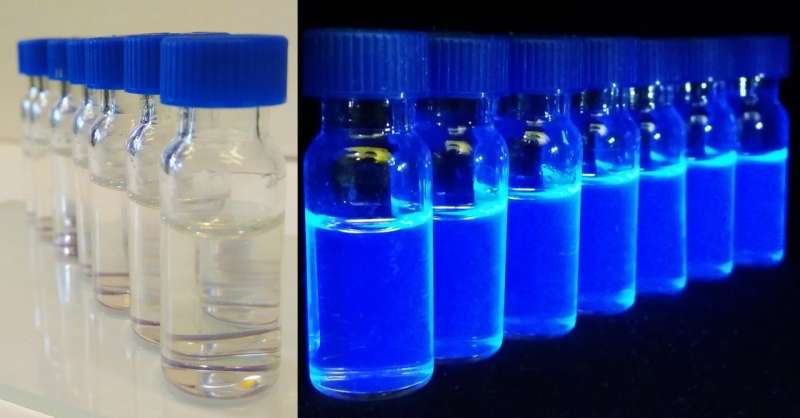New molecules for OLEDs and pharmaceuticals

Chemists from Ural Federal University (UrFU, Ekaterinburg) have suggested a new technique for synthesizing thiophene derivatives and studied their fluorescent properties experimentally as well as theoretically. Many organic compounds containing thiophene rings exhibit significant pharmacological activity. Thanks to their unusual electronic nature and low aromaticity, thiophenes are an ideal molecule for synthesizing photoactive polymers, liquid crystals and organic dyes for solar cells. The researchers described their discovery in Chemistry—An Asian Journal.
The research collaborative reports a convenient and effective two-step procedure for producing new thiophene derivatives from simple, common starting materials. They have determined the features of the mechanism of this reaction using quantum mechanical calculations to compute the reaction thermodynamic parameters, as well as to compare the electronic structure of active centers, to plot the structure of intermediate substances, and to investigate their intramolecular interactions.
The proposed method is promising due to its safe reaction conditions, suggesting that this protocol may provide a viable alternative to previously reported protocols, which are tedious, time consuming, and use dangerous conditions to produce low yields. Moreover, the new procedure can be used to synthesize libraries of new thiophene derivatives whose structures include new combinations of substituents, depending on the requirements of specific applications.
The compounds obtained possess important photophysical properties, in particular fluorescence. Molecules and materials with fluorescent properties are of great interest to the field of organic photonics for creating luminescent and photovoltaic devices. State-of-the-art quantum mechanical methods were used to interpret the experimental results and study the characteristics of the ground and excited states of these new compounds. Due to their photophysical properties and sensitivity to the environment, these synthesized compounds may found applications in many areas, especially in biology, because of their structural similarity with biologically active thiophenes.
The article published in the Chemistry—An Asian Journal is the fourth paper dedicated to new heterocyclic fluorophores published in 2017 by the team of chemists from UrFU. Previously, they developed a procedure for synthesizing 2-aryl-1,2,3-triazoles, and studied their fluorescent properties. In addition, they have proposed a new technique for the synthesis of 4,5-dihydro-1,2,4-triazoles and showed that their accessibility, synthetic simplicity, stability and high sensitivity to the microenvironment make them a convenient platform for creating new sensors.
Based on the results obtained, the researchers are proceeding to design, synthesize and investigate the fluorescent properties of compounds, which are promising candidates for practical use in biology or medicine.
Journal information: Chemistry - An Asian Journal
Provided by Ural Federal University




















